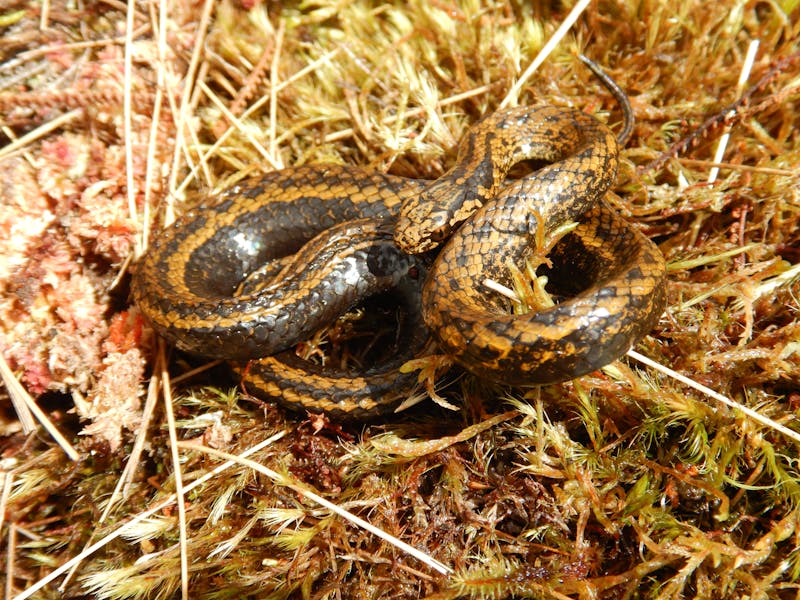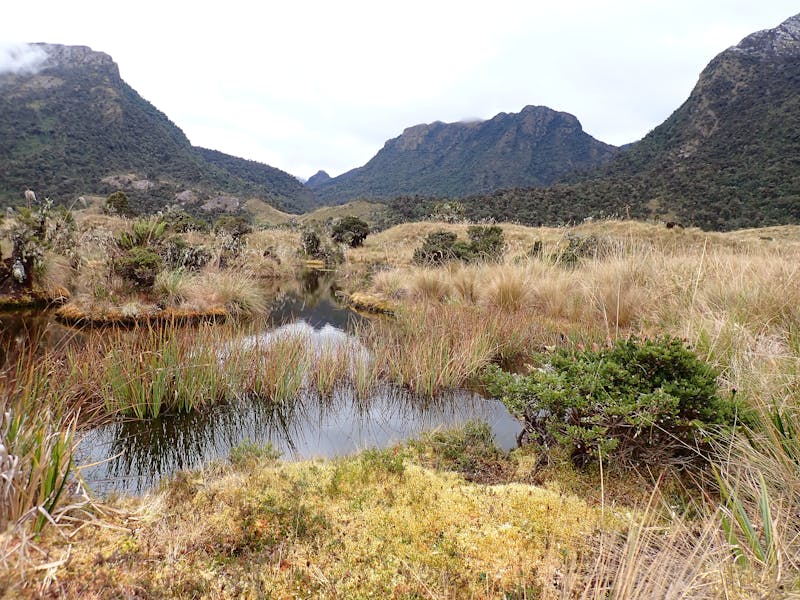High in the Andes Mountains, a team of researchers treks through an alpine swamp. Sifting through tall grass, they search for something priceless in the far reaches of a plateau patrolled by armed gunmen. Each footstep brings the team closer to a snake, coiled in the rushes. Its scales are threaded in copper; it stares through amber eyes.
If this sounds like a scene from an Indiana Jones movie, you’re not far off — starting with the fact that the snake’s name is Harrison Ford.
At least, it is now.
The snake’s actual name is Tachymenoides harrisonfordi, and it is a species new to science.
Tachymenoides harrisonfordi is a slender snake, measuring a modest 16 inches when fully grown. The well-camouflaged predator is harmless to humans, though it does have an appetite for lizards and frogs. While the diminutive reptile itself is hardly the stuff of adventure films, its discovery took researchers on a pulse-pounding journey worthy of Hollywood.
Tachymenoides harrisonfordi, named in honor of Harrison Ford. © Edgar Lehr, courtesy of Conservation International
A journey to Otishi
Led by biology professor Edgar Lehr of Illinois Wesleyan University, a team of scientists from Peru and the United States were the stars of this real-life expedition into Peru’s Otishi National Park— one of the least explored grasslands on Earth, largely accessible only by helicopter — where they stumbled upon the lone male snake sunbathing on a mountaintop pass.
The scientists trekked through a dangerous region dubbed “Peru’s cocaine valley,” where they soon realized they had unwittingly made camp near a clandestine cartel landing strip — and were being shadowed by narco-traffickers.
“I carried a walkie-talkie so we could communicate if the team was separated,” Lehr recounted. “On the ninth day of the trip, I suddenly heard unfamiliar voices coming through the speaker. We were in this incredibly remote location, so we immediately knew that there were other people around who were using the same radio frequency — channel eight. The voices seemed to hear us, too, and they sounded shocked.”
Each day brought new reminders that they were being watched. One morning, Lehr woke to the sound of buzzing above his tent. Bleary-eyed, he faintly wondered if it was a hummingbird. It turned out to be a drone, surveying them. Later that day, fresh footprints were discovered at the edge of their encampment.
But Lehr and his team persisted in their work. In addition to the discovery of the snake, they also encountered and subsequently named a waterfall, a swamp and a species of lizard. But on daybreak of the 11th day, they heard the unmistakable sound of a plane engine nearby.
Fearing for their lives, the team made the difficult choice to end the trip a week early. Lehr remembers feeling devastated. “There’s so much left to discover here,” he said. “I worry that further research here won’t be possible now.”
After four tense days of rainstorms, a Peruvian Air Force helicopter came to their rescue. As it descended toward the team, hovering just above the ground, Lehr remembers collapsing in the mud as he hurried aboard, the force of the churning blades sucking the air from his lungs. The captain welcomed them aboard with a handshake.
“Was it worth it?” Lehr said. “Yes — discovering new species, including Harrison Ford’s snake, is always worth it.”
Peru’s Otishi National Park, where the snake was discovered. © Edgar Lehr, courtesy of Conservation International
The snake’s namesake
The team named the new species in honor of Harrison Ford’s decades-long environmental advocacy. As vice chairman of Conservation International, he has been a tireless advocate for nature, whether on the world stage or as the voice of “The Ocean” in the organization’s award-winning “Nature is Speaking” campaign.
But unlike the fictional Indiana Jones, who was famously ophidiophobic (“I hate snakes, Jock! I hate ’em!”), the actor reportedly likes snakes — and found a quick kinship with this one.
“The snake’s got eyes you can drown in, and he spends most of the day sunning himself by a pool of dirty water — we probably would’ve been friends in the early ‘60s,” Ford said in a characteristically dry statement.
“In all seriousness, this discovery is humbling. It’s a reminder that there’s still so much to learn about our wild world — and that humans are one small part of an impossibly vast biosphere. On this planet, all fates are intertwined, and right now, one million species are teetering on the edge of oblivion. We have an existential mandate to mend our broken relationship with nature and protect the places that sustain life.”
Discovering and describing new species is crucial for scientists, helping them identify what requires protection, and where.
But in some cases, species are disappearing before humans even know they exist. Scientists have described around 1.2 million species on Earth — a small fraction of the 8.7 million species that are estimated to exist. There are likely millions more varieties of plants and animals that remain unknown — and at the current rate of discovery and extinction, there is almost no way scientists will find them all or understand their unique role in maintaining Earth’s ecosystems.
Reptiles are particularly vulnerable. A recent study co-authored by Conservation International researchers determined that more than a fifth of all reptiles are currently threatened with extinction.
“Only organisms that are known can be protected,” said Lehr, adding that he hopes Tachymenoides harrisonfordi’s discovery will draw attention to the extinction crisis facing species around the world. And having the slender snake share its name with one of the most widely recognized actors of his (or any) generation can’t hurt.
The snake is not even the first to be species to be named for Ford.
In 1993, American arachnologist Norman Platnick honored the Hollywood legend, dubbing a newly discovered Californian spider Calponia harrisonfordi. A decade later, the entomologist E.O. Wilson gifted the actor an ant species: Pheidole harrisonfordi.
Somehow, though, the fact that it’s a snake feels different — a fitting tribute to one of the world’s most famous conservationists and a nod to his enduring film character.
Will McCarry is a staff writer at Conservation International. Want to read more stories like this? Sign up for email updates. Also, please consider supporting our critical work.







